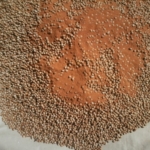


Mbarara Zonal Agricultural Research and Development Institute
Local Government - Dpeartment of Production, Marketing & Extension, Makerere University
Uganda
8/2015—8/2018
Cowpea (Vigna unguiculata), Chickpea (Cicer arietinum) and Pigeon pea (Cajanus cajan) are cultivated on over 11 million ha in Africa; this represents 43% of total area under pulses. Just under 33% percent of this areas if under cowpea production, with the remaining 4.7 % and 6.3 % are under chickpea and pigeon pea, respectively (FAOSTAT, 2011). All three of these legumes are important in African smallholder farming systems due to their high drought tolerance. However, high volumes of these grain legumes are lost during storage, mostly to a group of beetles known as bruchids. Bruchid adults lay their eggs in the field and/or store and the larvae quickly develop inside the grains; these infestations reduce the quantity and quality of untreated legume grains. To avoid the storage losses that invariably develop in untreated grains, farmers may sell their legumes after harvest when prices are low; those that store grain for future use usually experience a rapid decline in legume quality, the longer the grain is stored. Moreover, the metabolic activity of the bruchids generates heat and moisture, which can favor the growth of mycotoxin producing fungi. With support from CCRP, Mbarara Zonal Agricultural Research Institute (MBAZARDI) and its partners promoted the production and utilization of chickpea, cowpea and pigeon pea for improved nutrition within banana farming communities of Isingiro district in South Western Agro-Ecological Zone (SWAEZ), Uganda. However, the bruchid damage inflicted on these legumes frustrated farmers’ efforts to increase their legume production and utilization. This project will thus explore appropriate storage and processing techniques for management of storage bruchids to improve household food, nutrition and income security among the smallholder farmers in SWAEZ.
Improved understanding of indigenous storage practices in SWAEZ. Understanding how farmers currently try to manage storage pests is a critical first step for devising improved management practices. The team’s work will include a survey, focus group discussion and key informant interviews to help understand the specifics of locally important practices. These will be carried out in three districts where the target legumes are widely grown. Reduced storage losses due to bruchids. The project will evaluate the efficacy of indigenous and introduced bruchid management strategies under laboratory and on-farm conditions in the target districts. This work, conducted by the project PI, should be improved by his participation in the 3rd workshop of CCRP’s Multi-Environment Trials Initiative, which will focus on the design of METS. Improved food safety of locally important grain legumes. The work will include a participatory evaluation of the agronomic and postharvest and handling practices that predispose cowpea, chickpea and pigeon pea to contamination with mycotoxins. The source and extent of contamination will be determined along the value chain from harvesting to processing, enabling the team to pinpoint the most strategic intervention points. Traditional legume processing methods also will be evaluated for their associated risks and relationship with mycotoxin contamination. Reduced negative interactions amongst bruchid infestations,control strategies and mycotoxin producting fungi . The impact of bruchid infestation, occurrence of mycotoxin producing fungi and storage method will be investigated through controlled experimentation.
Outputs
Outcomes
